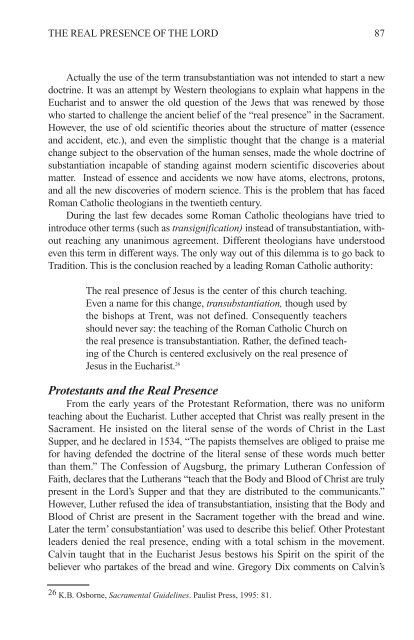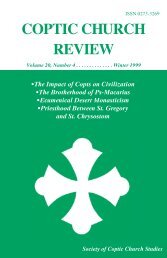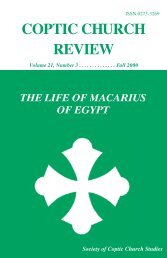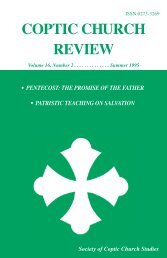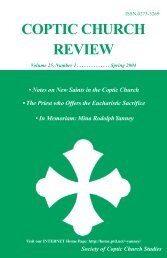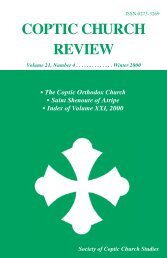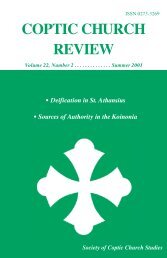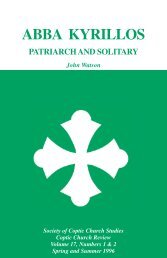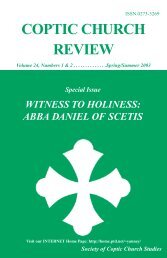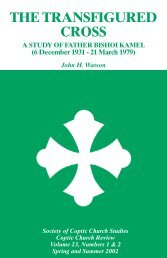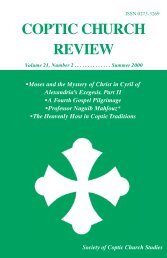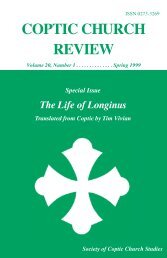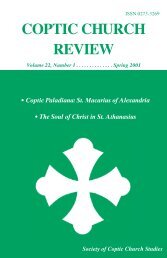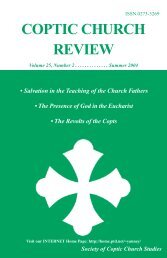2004 Fall.Vol25.#3.pdf - Coptic Church Review
2004 Fall.Vol25.#3.pdf - Coptic Church Review
2004 Fall.Vol25.#3.pdf - Coptic Church Review
Create successful ePaper yourself
Turn your PDF publications into a flip-book with our unique Google optimized e-Paper software.
THE REAL PRESENCE OF THE LORD 87<br />
Actually the use of the term transubstantiation was not intended to start a new<br />
doctrine. It was an attempt by Western theologians to explain what happens in the<br />
Eucharist and to answer the old question of the Jews that was renewed by those<br />
who started to challenge the ancient belief of the “real presence” in the Sacrament.<br />
However, the use of old scientific theories about the structure of matter (essence<br />
and accident, etc.), and even the simplistic thought that the change is a material<br />
change subject to the observation of the human senses, made the whole doctrine of<br />
substantiation incapable of standing against modern scientific discoveries about<br />
matter. Instead of essence and accidents we now have atoms, electrons, protons,<br />
and all the new discoveries of modern science. This is the problem that has faced<br />
Roman Catholic theologians in the twentieth century.<br />
During the last few decades some Roman Catholic theologians have tried to<br />
introduce other terms (such as transignification) instead of transubstantiation, without<br />
reaching any unanimous agreement. Different theologians have understood<br />
even this term in different ways. The only way out of this dilemma is to go back to<br />
Tradition. This is the conclusion reached by a leading Roman Catholic authority:<br />
The real presence of Jesus is the center of this church teaching.<br />
Even a name for this change, transubstantiation, though used by<br />
the bishops at Trent, was not defined. Consequently teachers<br />
should never say: the teaching of the Roman Catholic <strong>Church</strong> on<br />
the real presence is transubstantiation. Rather, the defined teaching<br />
of the <strong>Church</strong> is centered exclusively on the real presence of<br />
Jesus in the Eucharist. 26<br />
Protestants and the Real Presence<br />
From the early years of the Protestant Reformation, there was no uniform<br />
teaching about the Eucharist. Luther accepted that Christ was really present in the<br />
Sacrament. He insisted on the literal sense of the words of Christ in the Last<br />
Supper, and he declared in 1534, “The papists themselves are obliged to praise me<br />
for having defended the doctrine of the literal sense of these words much better<br />
than them.” The Confession of Augsburg, the primary Lutheran Confession of<br />
Faith, declares that the Lutherans “teach that the Body and Blood of Christ are truly<br />
present in the Lord’s Supper and that they are distributed to the communicants.”<br />
However, Luther refused the idea of transubstantiation, insisting that the Body and<br />
Blood of Christ are present in the Sacrament together with the bread and wine.<br />
Later the term’ consubstantiation’ was used to describe this belief. Other Protestant<br />
leaders denied the real presence, ending with a total schism in the movement.<br />
Calvin taught that in the Eucharist Jesus bestows his Spirit on the spirit of the<br />
believer who partakes of the bread and wine. Gregory Dix comments on Calvin’s<br />
26 K.B. Osborne, Sacramental Guidelines. Paulist Press, 1995: 81.


